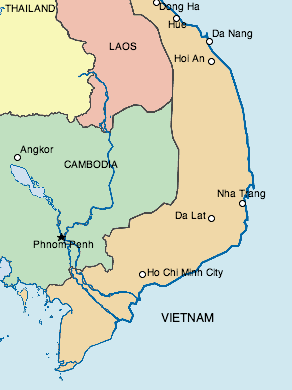The Myth of “Nam”

The male fantasy of Saigon that was nurtured in Graham Greene’s “The Quiet American” written in the 1950’s is recreated superficially in bars in Saigon with names like Apocalypse Now and B4 75 where, to the pulse of 1960’s music like The Doors, Vietnamese women again run their hands over the backs of young and adventurous American males with a trust fund…love-you-long-time-you-be-my-big-honey…the twenty-something young guy at the next internet terminal says to his friend behind him…only god saved my life last night! “Nam,” says Lonely Planet guidebook, is a myth bound up with sex, drugs and a rock and roll soundtrack…with images of war, of the smell of napalm in the morning and hookers at night.
First of all, Vietnam is nothing like the mythical “Nam” that is portrayed in most of the post Vietnam literature and film which is that if Americans are caricatures of heavy handed bellicosity, then Vietnamese must be contemplative and peace loving. The jungle was no easier a habitat than it was for the Americans. Bao Ninh, a former North Vietnamese soldier who wrote “The Sorrow of War” (that every young boy in every city tries to sell you) described the forests of central Vietnam through which the many branches of the Ho Chi Minh Trail was carved, as alien: “Here when it is dark, trees and plants moan in awful harmony. When the ghostly music begins it unhinges the soul and the entire wood looks the same no matter where you are standing….living here one could go mad or be frightened to death.”
Writings on Vietnam, according to Robert Templer in his “Shadows and Wind” published in 1998 in the UK, doesn’t take into account the diverse mix of religious and political beliefs that are evolving and changing. Vietnamese fighters were not all heroic martyrs as the propaganda in the museums of Hanoi would have you believe; many did not understand why they were fighting. But the creation of “Nam” and the concept of “Indochine,” French colonial nastalgia, was not possible without complicity on the part of powerful Vietnamese officials, according to Templer; creating a playground of colonial and war memories was a way for the government to mend broken ties and sell the country to tourists. It also had the side effect of isolating foreigners and distracting them from the widening ideological, economic and social issues that afflicted the country. Guilt and sadness that inflected the writing of American reporters who produced books on their returns to Vietnam in the 1990’s tended to offer only the most gentle criticisms of the government. As Templer puts it, “the government ensured that journalists and writers spent more time examining a past over which the government could exercise some control rather than a present that is slipping away from them.”
Tags: History, Reading, Reflections, Viet Nam


Leave a Reply